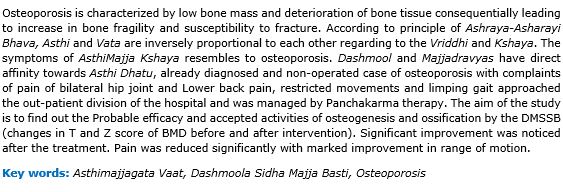Assessment of Osteoporosis (Asthi-Majja Kshaya) w.s.r. to BMD with Dashmool Majja Siddha Sneha Basti
Keywords:
Asthimajjagata Vaat, Dashmoola Sidha Majja Basti, OsteoporosisAbstract
Osteoporosis is characterized by low bone mass and deterioration of bone tissue consequentially leading to increase in bone fragility and susceptibility to fracture. According to principle of Ashraya-Asharayi Bhava, Asthi and Vata are inversely proportional to each other regarding to the Vriddhi and Kshaya. The symptoms of AsthiMajja Kshaya resembles to osteoporosis. Dashmool and Majjadravyas have direct affinity towards Asthi Dhatu, already diagnosed and non-operated case of osteoporosis with complaints of pain of bilateral hip joint and Lower back pain, restricted movements and limping gait approached the out-patient division of the hospital and was managed by Panchakarma therapy. The aim of the study is to find out the Probable efficacy and accepted activities of osteogenesis and ossification by the DMSSB (changes in T and Z score of BMD before and after intervention). Significant improvement was noticed after the treatment. Pain was reduced significantly with marked improvement in range of motion.
Downloads
References
Vagbhata, Astang Sthan edition, Sarvangasundaravyakhya by Ayurveda Rasayanateeka by Hemadri, Choukambasubharatiprakashan, Varanasi, edition,
Chakrapani on Agnivesha- Charaka samhita, revised by Caraka Samhita, revised by Caraka and Dhridabala with Ayurveda Dipika commentary by Chakrapani Dutta,edited by Vaidya Yadavji Trikamji Acarya, Chaukhamba Sanskrit Sansthan,, Varanasi 5th edition, 2001, Chikitsa Sthan
WHO 1994. "Assessment of fracture risk and its application to screening for postmenopausal osteoporosis. Report of a WHO Study Group". World Health Organization technical report series 843: 1-129.
Singh BB, Mishra LC, Vinjamury SP, Aquilina N, Singh VJ, Shepard N. 2003. The effectiveness of Commiphora mukul for osteoarthritis of the knee: An outcomes study. Altern. Ther. Health Med., 9(3):
R. K. Sharma, Bhagwan Dash. Editor, Charaka Samhita, Sutthrastana chapter 28 verse 27, 1st Vol, Varanasi, Chaukhamba Sanskrit Series Office, 2014; 579.
Jansz M., Rajoria K., Singh S.K., Panchkarma procedures along with Thrayodashanga guggulu in the management of katishool with special reference to lumber spondylosis, Int. J. Res. Ayurveda Pharm, Jul-Aug 2016; 7(4): 50-54.
Shastri Kashinath, Chaturvedi Gorakhnath edited Charak Samhita of Agnivesha, revised by Charaka and Dridhbala, part II, Chaukhambha Bharati Academy, Varanasi. Reprint, 2009; Chikitsha Sthana 28, verse 124-127; page no; 712.
Abeynayake P, Jansz M, Rajoria K., Singh S.K, Role of Rajayapana basti with reference to Duchenne Muscular Dystrophy, Int. J. Res. Ayurveda Pharm, Sep-Oct 2016; 7(4): 7-10 http://dx.doi.org/10.7897/2277-4343.075208.















